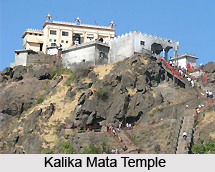 Kalika Mata Temple, one of the oldest shrines of the region, is located in the midst of a dense forest at the peak of the Pavagadh Hill in Panchmahal district in Gujarat. Kalika Mata means `the black Mother` is positioned inside the Champaner-Pavagadh Archaeological Park. The temple, under the UNESCO World Heritage Site, is located at an elevation of 2,500 ft above sea level.
Kalika Mata Temple, one of the oldest shrines of the region, is located in the midst of a dense forest at the peak of the Pavagadh Hill in Panchmahal district in Gujarat. Kalika Mata means `the black Mother` is positioned inside the Champaner-Pavagadh Archaeological Park. The temple, under the UNESCO World Heritage Site, is located at an elevation of 2,500 ft above sea level.
History of Kalika Mata Temple
Kalika Mata, dating back to the 11th century, is said to have been initially revered by the Bhil Tribe and Koli Tribe. Later the deity was installed on the summit of Pavagadh Hill by sage Vishvamitra. Since then the deity is worshipped as a form of Goddess Durga and Chandi. Kalika Mata temple finds its mention in a 15th century drama, Gangadas Pratap Vilasa Natakam. As per mythological references, it is believed that the temple is one of the Shakti Peethas where the toe of the goddess Sati has fallen.
Architecture of Kalika Mata Temple
The temple with its large fortifications and an open chowk in front echoes the exuberance and proficiency of the ancient period artisans. The temple adorned with two altars in front has been alienated into two portions. The Hindu shrines encompass the ground floor while a Muslim shrine decorates the temple spire. Besides this, a mausoleum of Sadan Shah Pir, a Sufi saint is also sited here.
Kalika Mata Temple enshrines three deities; the image of Kalika Mata is installed in the centre and is flanked by idols of Goddess Kali on the right side and Bahucharamata on the left side. Kalika Mata, red in colour, is portrayed in the form of a head, known as mukhwato. The exquisite marble floor of the shrine that dates back to almost 1859 was gifted by the minister of Limbdi of Kathiawar.
Kalika Mata Temple, one of the biggest pilgrimage centres of the state celebrates several festivals attracting pilgrims from different corners. Every year on Chaitra Sud 8 the temple organises a fair, attended by hordes of pilgrims. The full moon day in the month of Chaitra and Dussehra are considered as important days drawing Hindus from different sections.
The ancient temple is well connected by different modes of transport. The temple can be accessed by a footpath leading through a jungle covering a distance of almost 5 kms. A cable car is also available to haul the tourists to the summit. The ropeway, 740 metres in length, was commissioned in 1986. Besides this, cars are also available from Vadodara to drive to Champaner-Pavagadh.











